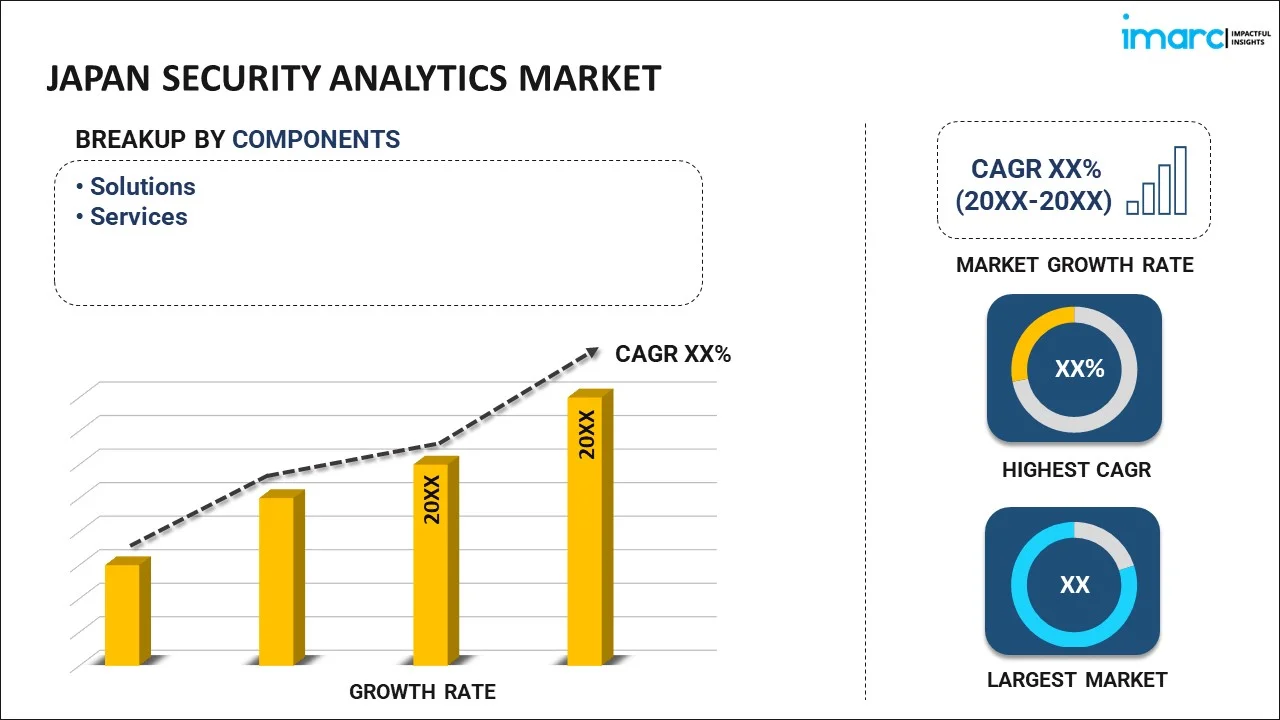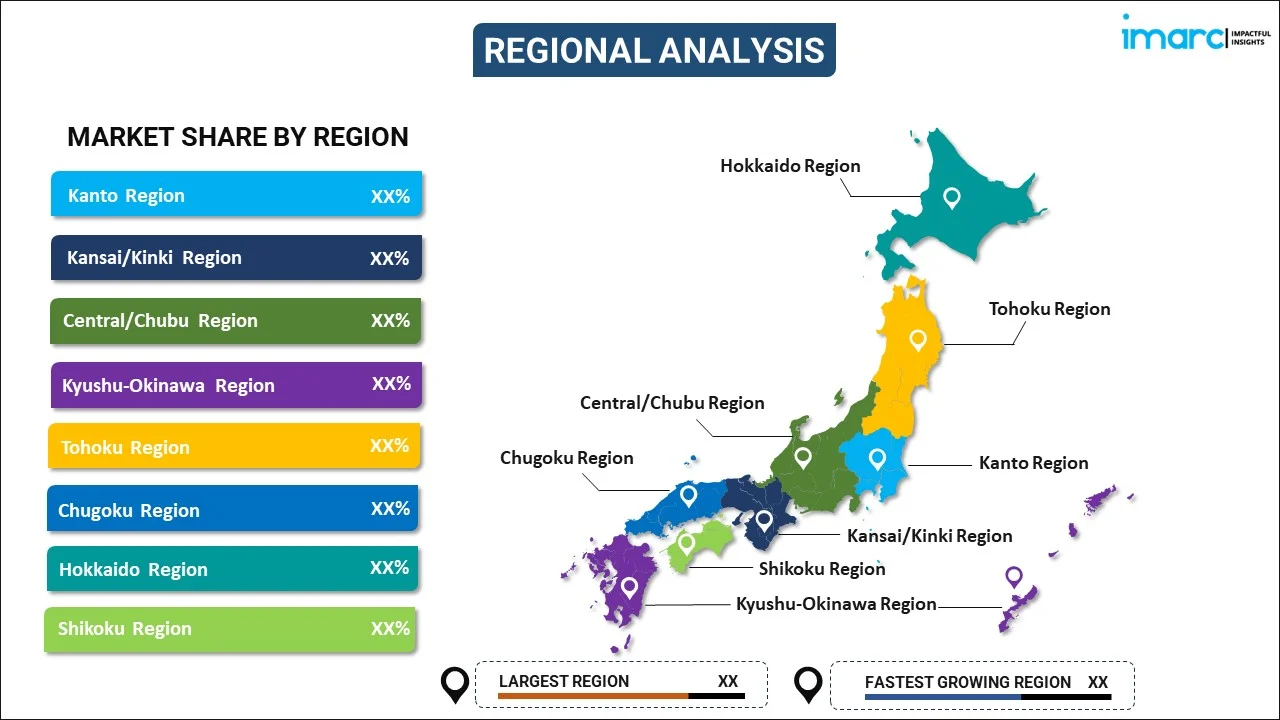
Japan Security Analytics Market Report by Component (Solutions, Services), Application (Application Security Analytics, Web Security Analytics, Endpoint Security Analytics, Network Security Analytics, and Others), Deployment Mode (Cloud-based, On-premises), Organization Size (Small and Medium-sized Enterprises, Large Enterprises), Vertical (BFSI, Healthcare, Manufacturing, Consumer Goods and Retail, IT and Telecom, Government and Defense, and Others), and Region 2025-2033
Market Overview:
Japan security analytics market size reached USD 352.5 Million in 2024. Looking forward, IMARC Group expects the market to reach USD 773.2 Million by 2033, exhibiting a growth rate (CAGR) of 9.1% during 2025-2033. The growing proliferation of data sources, including internet of things (IoT) devices, social media, and cloud-based platforms, rising number of cyber threats, and increasing maturation of the regulatory landscape represent some of the key factors driving the market.
|
Report Attribute
|
Key Statistics
|
|---|---|
|
Base Year
|
2024
|
|
Forecast Years
|
2025-2033
|
|
Historical Years
|
2019-2024
|
| Market Size in 2024 | USD 352.5 Million |
| Market Forecast in 2033 | USD 773.2 Million |
| Market Growth Rate 2025-2033 | 9.1% |
Security analytics is employed for collecting, analyzing, and interpreting data from various sources within the information technology (IT) environment of an organization to identify potential security threats and vulnerabilities. It comprises network security analytics, which focuses on monitoring network traffic for suspicious activity, identifying intrusions, and detecting malicious communication patterns. It includes endpoint security analytics, which analyzes data from endpoints (computers and mobile devices) to detect malware, unauthorized access, and unusual user behavior. It also consists of user and entity behavior analytics, which concentrates on monitoring and analyzing the behavior of users and entities, helping to identify insider threats and compromised accounts. It encompasses application security analytics, which focuses on the security of applications, identifying vulnerabilities and unusual application behavior that may indicate an attack. It involves the application of data science, machine learning (ML), and artificial intelligence (AI) to gain insights into security events and trends. It helps in reducing the time attackers remain undetected within a network, limiting the potential damage they can cause. It also aids in meeting regulatory and compliance requirements by providing the necessary evidence of security controls and incident response. Besides this, it enables organizations to allocate resources efficiently by focusing on areas of high risk.
Japan Security Analytics Market Trends:
At present, the escalating demand for sophisticated analytics solutions, driven by an ever-evolving threat landscape and the imperatives of safeguarding digital assets, represents one of the crucial factors impelling the growth of the market in Japan. Besides this, the proliferation of data sources, including internet of things (IoT) devices, social media, and cloud-based platforms, is inundating organizations with vast volumes of information that must be scrutinized for potential security threats. This is also giving rise to a critical need for advanced analytics tools and technologies that can process, correlate, and analyze this influx of data efficiently. Additionally, the rising sophistication of cyber threats is encouraging organizations to embrace proactive security measures. Moreover, the maturation of the regulatory landscape and increasing focus on compliance and data privacy regulations are compelling organizations operating in the country to invest in robust security analytics solutions. Security analytics platforms can provide detailed insights into data usage and potential breaches and are instrumental in assisting organizations in meeting these regulatory requirements. Apart from this, the persistent shortage of expertise in cybersecurity maintenance is compelling companies to invest in effective security analytics solutions. Furthermore, the increasing integration of cloud-native security analytics solutions, which can analyze both on-premises and cloud-based data, is bolstering the market growth in the country.
Japan Security Analytics Market Segmentation:
IMARC Group provides an analysis of the key trends in each segment of the market, along with forecasts at the country level for 2025-2033. Our report has categorized the market based on component, application, deployment mode, organization size, and vertical.
Component Insights:

- Solutions
- Services
- Professional Services
- Managed Services
The report has provided a detailed breakup and analysis of the market based on the component. This includes solutions and services (professional services and managed services).
Application Insights:
- Application Security Analytics
- Web Security Analytics
- Endpoint Security Analytics
- Network Security Analytics
- Others
A detailed breakup and analysis of the market based on the application have also been provided in the report. This includes application security analytics, web security analytics, endpoint security analytics, network security analytics, and others.
Deployment Mode Insights:
- Cloud-based
- On-premises
The report has provided a detailed breakup and analysis of the market based on the deployment mode. This includes cloud-based and on-premises.
Organization Size Insights:
- Small and Medium-sized Enterprises
- Large Enterprises
A detailed breakup and analysis of the market based on the organization size have also been provided in the report. This includes small and medium-sized enterprises and large enterprises.
Vertical Insights:
- BFSI
- Healthcare
- Manufacturing
- Consumer Goods and Retail
- IT and Telecom
- Government and Defense
- Others
The report has provided a detailed breakup and analysis of the market based on the vertical. This includes BFSI, healthcare, manufacturing, consumer goods and retail, IT and telecom, government and defense, and others.
Regional Insights:

- Kanto Region
- Kansai/Kinki Region
- Central/ Chubu Region
- Kyushu-Okinawa Region
- Tohoku Region
- Chugoku Region
- Hokkaido Region
- Shikoku Region
The report has also provided a comprehensive analysis of all the major regional markets, which include Kanto Region, Kansai/Kinki Region, Central/ Chubu Region, Kyushu-Okinawa Region, Tohoku Region, Chugoku Region, Hokkaido Region, and Shikoku Region.
Competitive Landscape:
The market research report has also provided a comprehensive analysis of the competitive landscape. Competitive analysis such as market structure, key player positioning, top winning strategies, competitive dashboard, and company evaluation quadrant has been covered in the report. Also, detailed profiles of all major companies have been provided.
Japan Security Analytics Market Report Coverage:
| Report Features | Details |
|---|---|
| Base Year of the Analysis | 2024 |
| Historical Period | 2019-2024 |
| Forecast Period | 2025-2033 |
| Units | Million USD |
| Scope of the Report | Exploration of Historical and Forecast Trends, Industry Catalysts and Challenges, Segment-Wise Historical and Predictive Market Assessment:
|
| Components Covered |
|
| Applications Covered | Application Security Analytics, Web Security Analytics, Endpoint Security Analytics, Network Security Analytics, Others |
| Deployment Modes Covered | Cloud-based, On-premises |
| Organization Sizes Covered | Small and Medium-sized Enterprises, Large Enterprises |
| Verticals Covered | BFSI, Healthcare, Manufacturing, Consumer Goods and Retail, IT and Telecom, Government and Defense, Others |
| Regions Covered | Kanto Region, Kansai/Kinki Region, Central/ Chubu Region, Kyushu-Okinawa Region, Tohoku Region, Chugoku Region, Hokkaido Region, Shikoku Region |
| Customization Scope | 10% Free Customization |
| Post-Sale Analyst Support | 10-12 Weeks |
| Delivery Format | PDF and Excel through Email (We can also provide the editable version of the report in PPT/Word format on special request) |
Key Questions Answered in This Report:
- How has the Japan security analytics market performed so far and how will it perform in the coming years?
- What has been the impact of COVID-19 on the Japan security analytics market?
- What is the breakup of the Japan security analytics market on the basis of component?
- What is the breakup of the Japan security analytics market on the basis of application?
- What is the breakup of the Japan security analytics market on the basis of deployment mode?
- What is the breakup of the Japan security analytics market on the basis of organization size?
- What is the breakup of the Japan security analytics market on the basis of vertical?
- What are the various stages in the value chain of the Japan security analytics market?
- What are the key driving factors and challenges in the Japan security analytics?
- What is the structure of the Japan security analytics market and who are the key players?
- What is the degree of competition in the Japan security analytics market?
Key Benefits for Stakeholders:
- IMARC’s industry report offers a comprehensive quantitative analysis of various market segments, historical and current market trends, market forecasts, and dynamics of the Japan security analytics market from 2019-2033.
- The research report provides the latest information on the market drivers, challenges, and opportunities in the Japan security analytics market.
- Porter's five forces analysis assist stakeholders in assessing the impact of new entrants, competitive rivalry, supplier power, buyer power, and the threat of substitution. It helps stakeholders to analyze the level of competition within the Japan security analytics industry and its attractiveness.
- Competitive landscape allows stakeholders to understand their competitive environment and provides an insight into the current positions of key players in the market.
Need more help?
- Speak to our experienced analysts for insights on the current market scenarios.
- Include additional segments and countries to customize the report as per your requirement.
- Gain an unparalleled competitive advantage in your domain by understanding how to utilize the report and positively impacting your operations and revenue.
- For further assistance, please connect with our analysts.
 Inquire Before Buying
Inquire Before Buying
 Speak to an Analyst
Speak to an Analyst
 Request Brochure
Request Brochure
 Request Customization
Request Customization




.webp)




.webp)












